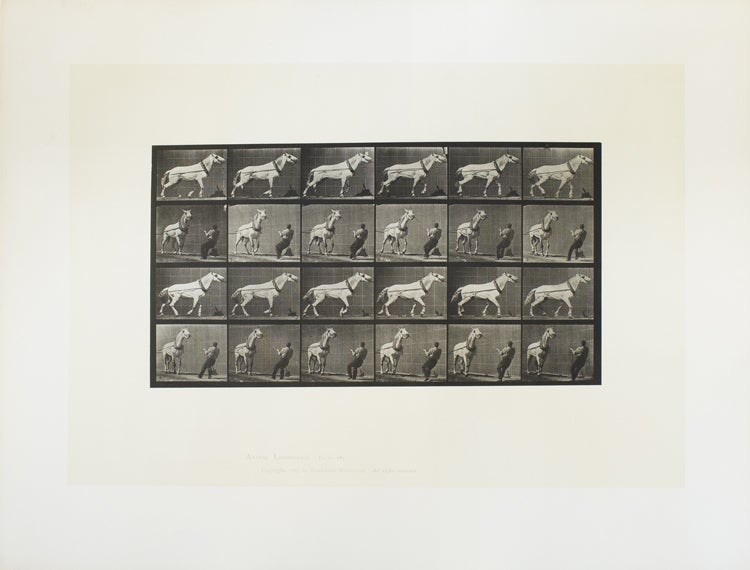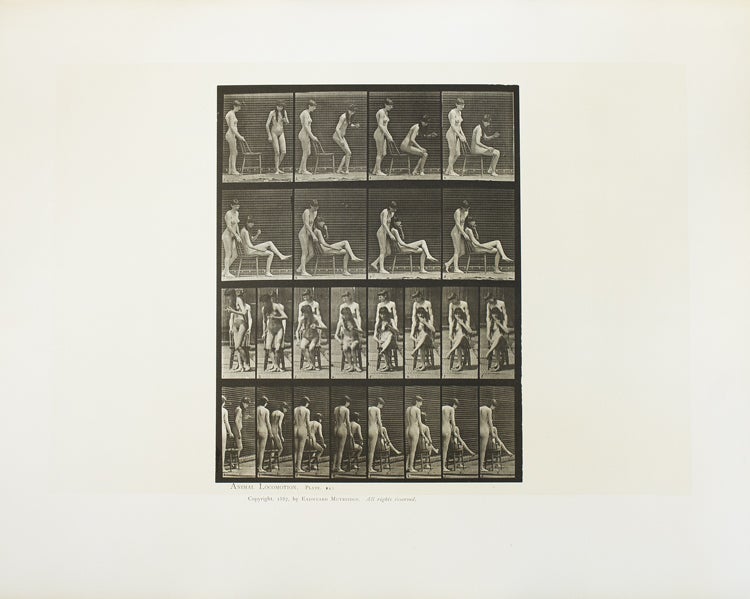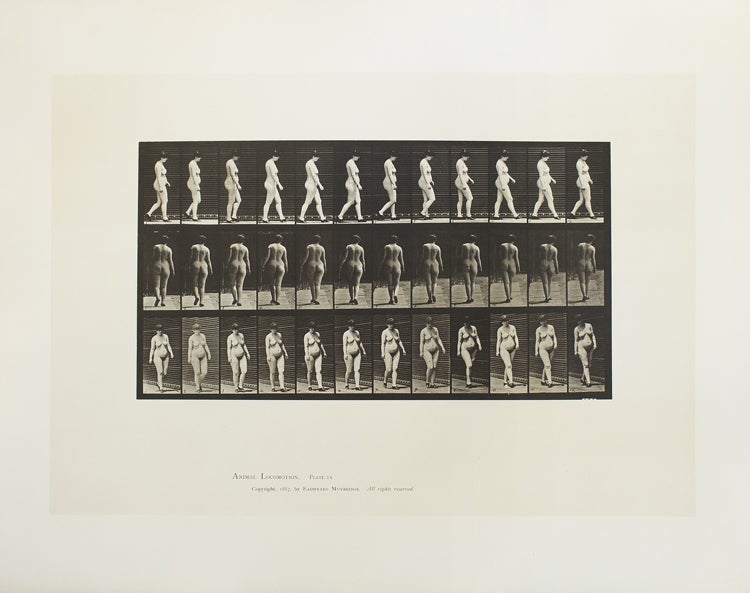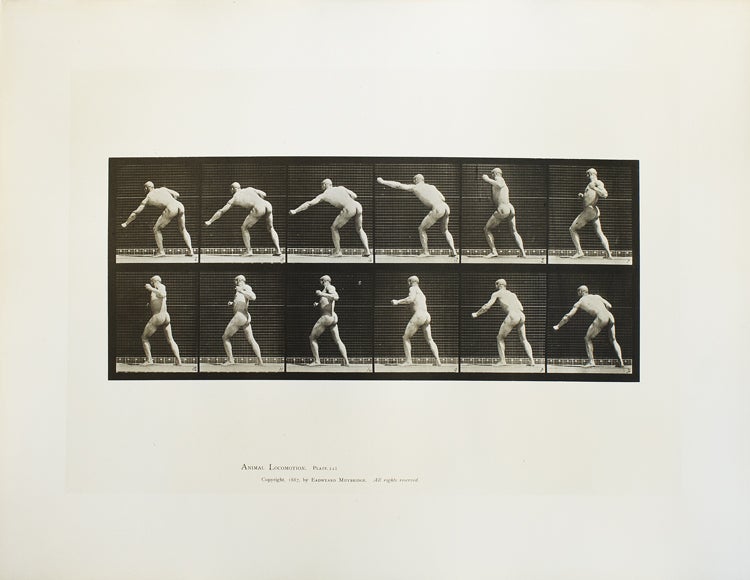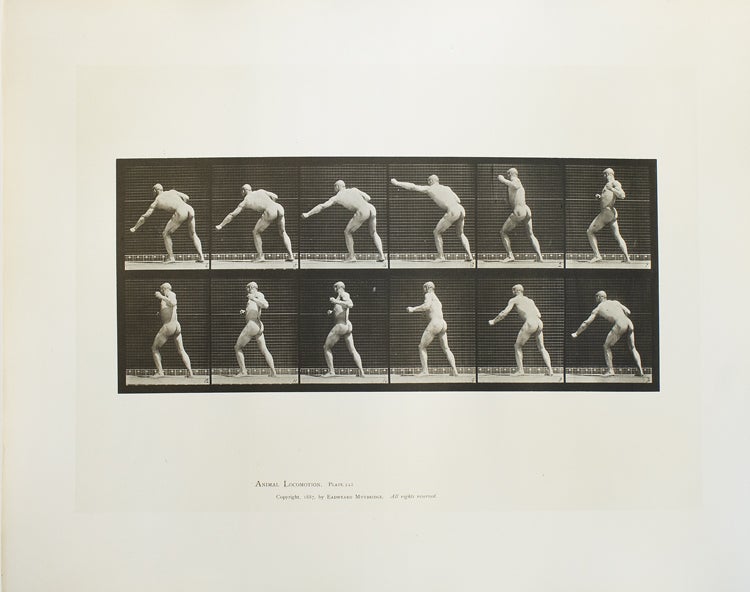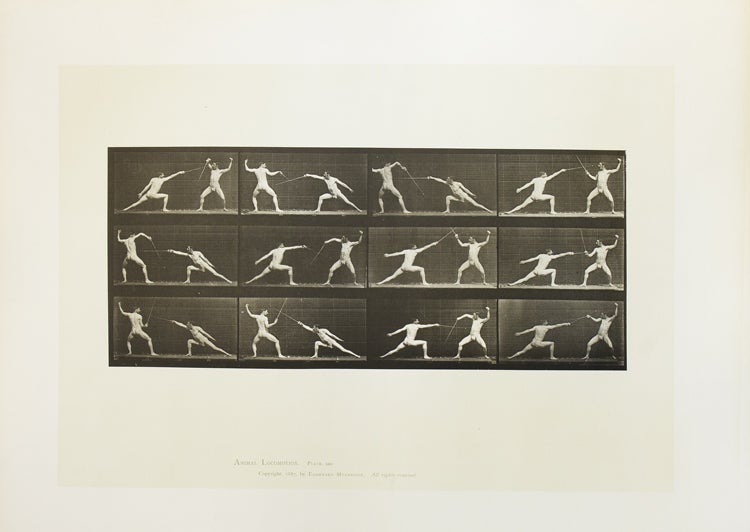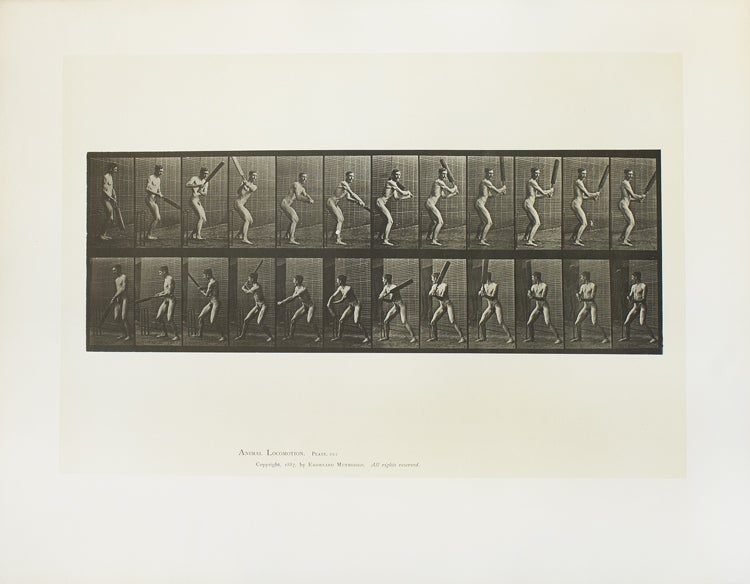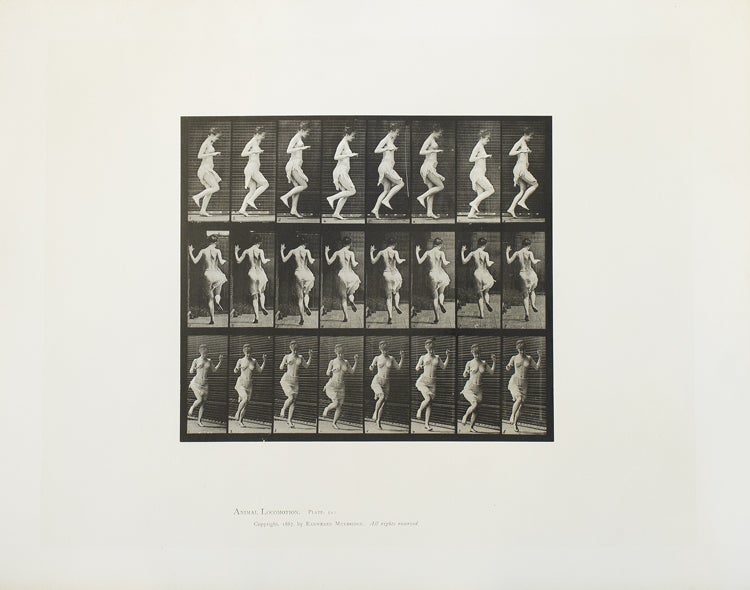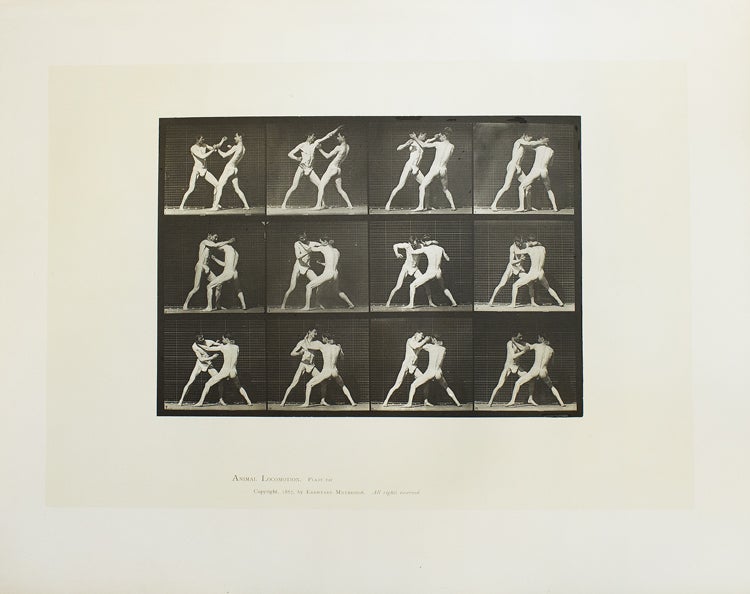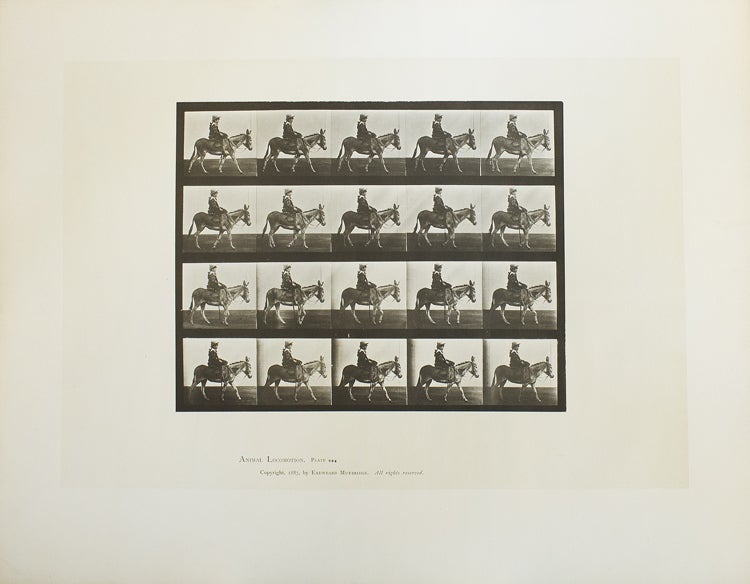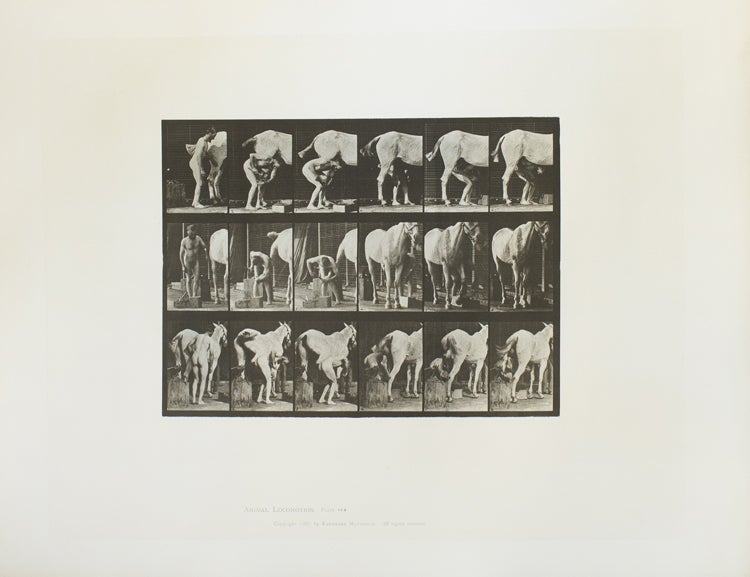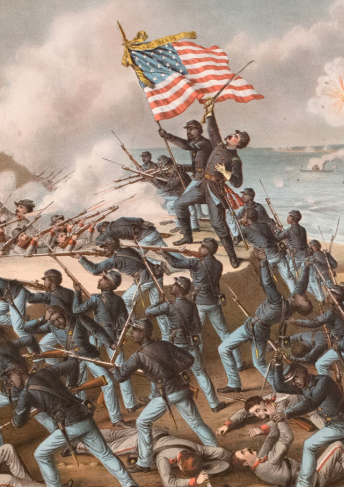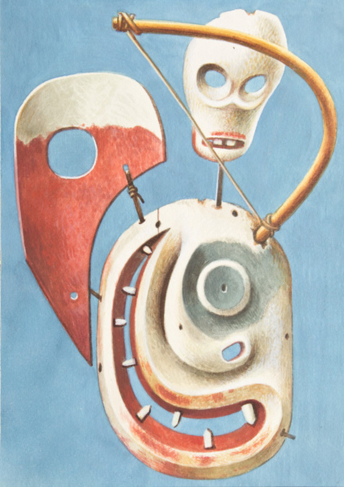A Major Landmark in photography
Animal Locomotion. An Electro-Photographic Investigation of Consecutive Phases of Animal Movements.
Philadelphia: University of Pennsylvania, 1887.
Price: $150,000.00
About the item
[Group of 120 plates from Animal Locomotion. An Electro-Photographic Investigation of Consecutive Phases of Animal Movements]. Philadelphia: The University of Philadelphia, 1887. Folio. 120 collotype plates by Muybridge, printed by the Photo-Gravure Company. Includes the following plate numbers: 1, 4, 6, 8, 9, 10, 24, 46, 73, 134, 166, 175, 176, 178, 179, 180, 181, 182, 183, 185, 198, 213, 223, 231, 239, 241, 247, 251, 254, 259, 269, 271, 279, 284, 286, 287, 288, 292, 293, 294, 300, 302, 311, 314, 317, 318, 321, 322, 323, 324, 326, 327, 328, 333, 340, 342, 343, 345, 349, 351, 352, 392, 393, 394, 395, 397, 399, 400, 401, 403, 405, 408, 410, 412, 414, 418, 420, 434, 436, 446, 465, 466, 468, 476, 477, 478, 480, 481, 484, 486, 489, 490, 493, 496, 497, 502, 503, 505, 507, 509, 511, 517, 518, 519, 520, 521, 522, 523, 525, 526, 527, 537, 538, 539, 543, 549, 556, 561, 573, and 666. 1 vols. Folio. A Major Landmark in photography. Black half morocco clamshell boxes. Roosens & Salu 723; Muybridge, Eadweard, Complete Human and Animal Locomotion, ed. A.V. Mozley; New York, 1979, vol. i, p. vii; Gernsheim, The History of Photography, pp. 440.
Item #312983
The first edition of this rare and important photographic work is a landmark in the evolution of the medium, and in the role of mechanical reproduction on the fine arts. Although the complete set of images for Animal Locomotion totaled 781 plates in eleven portfolios, the prohibitively high cost of $600 resulted in the purchase of only thirty-seven complete sets of all 781 plates.
However, as Muybridge explains in the Prospectus, the makeup of the subscription sets was left entirely up to each subscriber, as long as at least one hundred plates were purchased: "One hundred Plates of illustrations will constitute a copy of the work. These one hundred plates, the Subscriber is entitled to select from those enumerated in the subjoined catalogue... The 781 Plates described in the Catalogue comprise more than 20,000 figures of men, women, and children, animals and birds, all actively engaged in walking, galloping, flying, working, playing, fighting, dancing, or other actions incidental to every-day life, which illustrate motion and the play of muscles...Subscribers desiring a greater number of Plates than the one hundred for which they subscribe, will be entitled to obtain such additions, and at the same proportionate rate of payment [one dollar per plate]."
Thus every Subscriber set of Animal Locomotion is different in its composition, depending on the interests and tastes of the subscriber. In addition to choosing their own images, subscribers were also able to order by "subjects" (i.e. men, women, children, etc. indicating for each the various states of dress or undress), with Muybridge selecting the images.
Eadweard Muybridge (1830-1904) was one of the great photographic innovators of the 19th century. Born in England, he came to San Francisco in 1855 and worked as a bookseller. After a serious accident in 1860, he returned to England, and changed his vocation to photographer. Returning to the United States in 1867, he built his reputation on photographs of San Francisco, Yosemite, and other western locales, both as a private photographer and working for the U.S. Government. Beginning in 1872 Muybridge, at the behest of the railroad magnate Leland Stanford, experimented with a sequence of photographs of a galloping horse that proved that all four of the animal's hooves were off the ground at the same time. By 1878 he had developed the ability to produce series of photographs freezing the motion of moving figures. These studies were published in 1882 as The Horse in Motion, which led to a break between Stanford and Muybridge, who felt he had not been given proper credit. Now committed to working on his motion studies, Muybridge found a new sponsor in the University of Pennsylvania, and moved to Philadelphia in 1883. "Largely owing to the advocacy of the esteemed artist and faculty member Thomas Eakins, Muybridge was engaged to conduct a series of locomotion studies at the University of Pennsylvania from 1884 to 1885. There he exposed more than 100,000 photographic plates in locomotion studies of men, women, children, beasts, and birds. The initial publication of this work in 1887 was comprehensive but prohibitively expensive" (ANB). Eakins worked with Muybridge as one of his assistants for part of this time. The photographs showed sequences of several dozen photographs on each plate. The human models, of both sexes, were shown nude or with minimal clothing engaged in various activities, from walking, running, leaping and throwing things to climbing stairs, carrying objects, engaging in various kinds of work, and many forms of athletic activity. Animals, drawn from the Philadelphia Zoo, are shown moving in various ways as well as carrying loads. The entire project was a comprehensive catalogue of human and animal motion. Muybridge's 1860 accident, which involved a blow to the head and possible brain injury, evidently changed his personality as well as his career. He became eccentric and explosive (in 1874 he killed his wife's lover, but was acquitted on the grounds of justifiable homicide) and also shed many inhibitions. His photography and publication of nude models was remarkable for its day. Many of the figures in Muybridge's work feature full-frontal nudity, both men and women, as well as some children. After the publication of Animal Locomotion, Muybridge worked for some time to promote commercial applications for his work before returning to England in 1894. He died there a decade later. Muybridge's work in sequential photography quickly had a major impact on the fine arts of his day, and laid the groundwork for motion pictures. His images remain exciting and vibrant today. In a search of OCLC, we locate nineteen sets that are complete or mostly so (more than 700 plates present). A further twenty-nine copies are located containing anywhere from 75 to 200 plates (copies of around 100 plates being the most common), and twelve more records with indeterminate or minimal holdings.
An incredibly important and handsome production, key in the history of science and photography.

